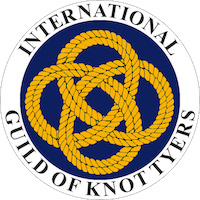Why Knot? by Philippe Petit
Abrams Image, 2013, ISBN 978-1-4197-0676-9
I rarely buy knot books these days and even more rarely read them from cover to cover, but WHY KNOT ? by Philippe Petit, long standing IGKT member, is different. Written and illustrated by the man who walked on a wire between New York’s Twin Towers in 1974, this is not just another book of knots, it is an experience.
It is written in a clear conversational style and covers, as he says, more than 60 ingenious, useful, beautiful, lifesaving and secure knots. This is a book of practical knots, splices and knot lore. There is not a Turk’s Head in sight, but the Monkey’s Fist is included, but then that has a very practical purpose. Philippe drew all the illustrations himself in a very simple but clear way, using colour from time to time for clarity, interspersed with delightful sketches and photographs of various of his performances, which give rise to a relevant, personal, and unique knot story.
But let’s start with the cover. Many publishers have struggled with the idea of providing a piece of rope with their book. “Why Knot?” has an extra thick cover with the “O” of KNOT a cut out space, covered with a clear window, filled with a beautiful coil of 4mm red cord. The rope is accessed from inside the cover and, when the rope is retrieved, the clear window displays the red figure of eight knot printed on the fly sheet: a most ingenious solution. This sort of planning and thinking goes on throughout the book. I have to confess that the rope looked so good that I left it in place, but then, like most IGKT members, I have a piece of rope in my pockets at all times.
Open up the book and on the inside of the fly sheet, without further ado, he invites you to “jump right in” and tie a square knot, explaining that this is his style, to get on with it. The introduction follows, “imagine a world without rope”, then the background to the book, about ropes, about knots and a section on the Ashley Book of Knots , the International Guild of Knot Tyers and Knotting Matters.
After this introductory part, he goes into his selection of knots: Binding Knots, Bends Securing and Freeing, Loops, Seizings and Lashings Running Knots, Lifesavers, Twines threads & Fishing lines, Splices and Closings. These various sections contain not just the tying instructions but alternative names , sometimes a tale, or some technical advice, sometimes a tip or a piece of history. Every now and then he slips in a surprise item; Magic, a Challenge or what he calls Extraordinary.
Throughout all of this Philippe Petit pays tribute to those writers before him who have given him the best ways of looking at a knot or tying it. Knotting Matters gets plenty of mentions. Indeed, the book ends with “On the Knotter’s Shelves” a wide ranging list of books, motion pictures, videos and websites, often with a brief comment, which is very useful.
WHY KNOT? is an enjoyable read, giving a personal perspective on practical knots. It is not for you if you want decorative knots or practical ropework projects, but buy it to read and get a slightly differing, slightly quirky, view of everyday knots in a book that has thoughtfully been put together, which has something for novice and informed knotter alike.
Quote from his book: “Personally, I find the content of KM to be at times unbalanced. Lately it seems to lean more toward retirees’ macrame achievements, social activities of the local branches, and personal announcements than knot essays and investigations. Also, the illustrations are at times not the best quality, and some of the articles (many of which are indeed interesting) could definitely use the help of a graphic designer.” pp 38-39.

